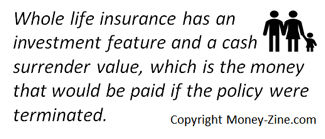Details Last Updated: Monday, 01 March 2021
A whole life insurance policy combines the benefits of a term policy with that of an investment. When paying the annual premium on this type of policy, the money needs to fund both of these components, so these policies are considered expensive when compared to benefit-efficient term insurance. Based on life insurance statistics, 52% of Americans have invested in life insurance.
Premiums on Whole Life Policies
During the early years of a whole life policy, a smaller portion of the premium will be used to pay for the cost of providing life insurance. But as the policyholder ages, the cost to provide coverage will rise, and a larger portion of the total premium will be used to pay for the insurance benefit. When that happens, a smaller portion of the premium will go towards the investment, or reserve.
Additional Resources |
Life Insurance Policies Life Insurance Selector Term Life InsuranceUniversal Life Insurance |
It's important to understand how this funding works, because it helps to establish the policyholder's expectations with respect to the cash value of their account and how it grows over time.
Cash Surrender Values
Because whole life insurance has this investment feature, the policy will also have a cash surrender value. This is the money that would be paid if the policyholder decided to give up or "surrender" their insurance policy. Alternatively, it's possible to use this cash value to pay for the cost of providing insurance in the future.

Whole life insurance is not a true investment option. Oftentimes insurance salespersons talk of the policy's rate of return as if this return is guaranteed. That is certainly not the case, and the paperwork will clearly explain the investment numbers are projections or hypothetical examples. This means the actual cash value of the account will likely be different than the original projections. In addition, the cash value of the policy comes at a cost. By adding an investment feature to the policy, whole life insurance premiums are higher than a policy that only provides a life insurance benefit. Individuals on a tight budget should not sacrifice the death benefit of their policy to fund an investment. The primary purpose of any life insurance policy is to provide coverage to protect family or loved ones from a financial hardship. Do not lose sight of this fact when dealing with an insurance salesperson. Despite the above, life insurance statistics say that 52% of Americans have invested in life insurance.
Policy Dividends
In addition to providing the policyholder with a cash value, certain whole life plans also provide for dividends. Dividends are paid when the actual cost to provide insurance turns out to be less than the insurance company assumed in their original forecast. When this occurs, the insurance company might return a percentage of the premium back to the policyholder in the form of a dividend. Once again, even if a policy carries this feature, payment of the dividend is never guaranteed.
Permanent Life Insurance
Because of the way insurance premiums are calculated, the policy is considered "permanent" life insurance. A permanent policy is one that will continue to provide coverage for as long as the owner continues to pay their annual premiums. Another important consideration when evaluating policies is the fact premiums for whole life policies are also usually "level." This means they will not increase over time. For policyholders that want insurance they can buy and forget about, a whole life policy makes a lot of sense; especially if they can afford the premiums.
Whole Life versus Term Insurance
The primary reason for purchasing life insurance is to provide the policy beneficiaries with a financially secure future. The least expensive way to buy this protection is through a term life insurance policy. That being said, it's worth summarizing the difference between whole life policies and term insurance:
Since whole life has an investment component, the policy accumulates a cash value over time. Term insurance policies do not provide a cash value to their owners.
Whole life is considered permanent life insurance. Term life insurance is just as the name implies; it is purchased for a term that can be as short as one year.
Whole life insurance policies are usually structured so the premium stays level over the life of the policyholder. With term insurance, especially one-year renewable term, the annual premium will likely increase as the policyholder ages.
Finally, term life insurance is considered benefit-efficient, since it does not have the investment feature found in whole life policies.
About the Author - Whole Life Insurance Policies



.jpg)
.jpg)